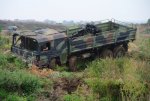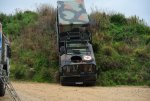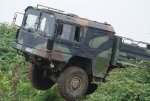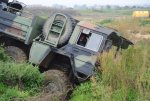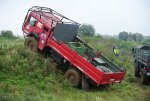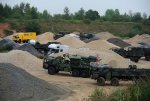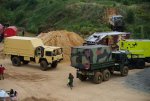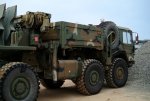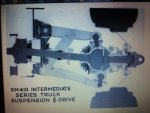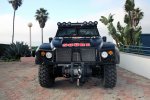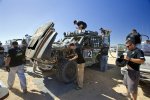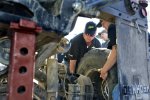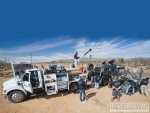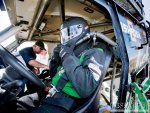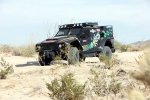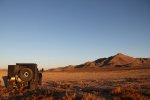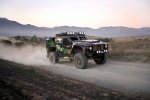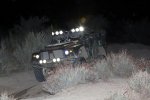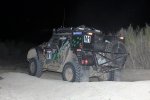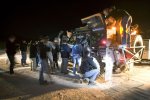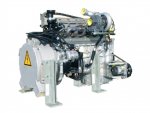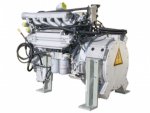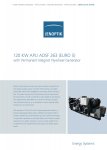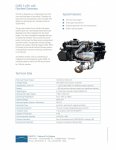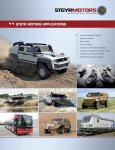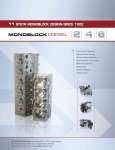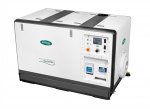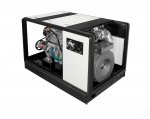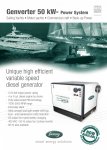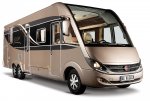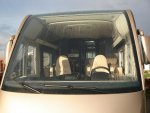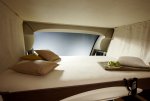..
Hi
campo!
Welcome to this thread. I was hoping that you would participate here, too.....

I've composed a very long response to your excellent post, because your post was so well-structured, and provided a really nice, itemized summary of the major design and engineering issues. The posts below follow the sequence of your email exactly.
*************************************************
1. Engineering Innovative, not Engineering Futuristic;
....Technology Available Now, but Not Yet Proven in an Expedition Motorhome Application
*************************************************
Hello Biotect and the others.
I do not want to interrupt your discussions but in order to let me make the thermal calculations
I would like to know if there is already some consensus about the project vehicle ?
.
Is it OK when I imagine your concept expedition RV vehicle as follows:
.
Will be built in 2017/2018 (innovative but not futuristic concept)
That's a
very nice way to describe the engineering target: "
innovative" but
not "
futuristic". It's just way too easy as a transportation designer to imagine just about any technology one likes, and then develop a "futuristic" design based on purely hypothetical technology. The resulting concept vehicles are not that interesting, because they are almost completely un-buildable in the near-term, i.e. in the next 20 years. Whereas "
innovative" sounds exactly right, at least in terms of mechanical engineering.
Earlier in the thread
thjakits made a similar set of distinctions:
Anything is possible - if you dream it up! For the sake of this discussion, you need to decide if you want to build your theoretical rig with "technology available now" - "....available in the near future" - "...available and PROVEN" - ....you see where this is going!!
This too struck me as excellent thinking. Needless to say, when designing a concept vehicle one rarely opts for
“….available and PROVEN”. This is something that
Aspire seemed unable to understand..... :ylsmoke: .
... On the other hand,
“….available in the near future” seems a bit too vague. Just about everything is
“available in the near future”. And as
Aspire rightly suggested, if one does not self-impose meaningful engineering limits, then one can dream up anything one likes, but one's dream will prove a mere idle fantasy.
So
"technology available now" but
“not yet proven” seems like the best ball-park. For instance, the Capstone C30 and C65 microturbines are
“available now”, but
“not yet proven in an expedition vehicle application”.
Other kinds of hybrid solutions based on more conventional ICE technology are already
“somewhat proven in an expedition vehicle application”. There is the latest diesel-electric Hybrid Range Rover, for instance – see
http://expeditionportal.com/land-rover-launches-new-range-rover-hybrid/ ,
http://expeditionportal.com/silk-road-expedition-2013-nears-the-finish/ ,
http://expeditionportal.com/land-roves-banner-year-of-expedition/ , and
http://expeditionportal.com/tag/hybrid/ . For a fully illustrated description of the “
Silk Trail” Hybrid Range-Rover test drive in 2013, Birmingham to Mumbai, see posts #365 to #380, at
http://www.expeditionportal.com/for...pedition-RV-w-Rigid-Torsion-Free-Frame/page37 and
http://www.expeditionportal.com/for...pedition-RV-w-Rigid-Torsion-Free-Frame/page38 . There is also a short thread about the Subaru XV Cross Trek Hybrid on ExPo – see
http://www.expeditionportal.com/forum/threads/118205-Subaru-XV-Cross-Trek-Hybrid .
So although hybrid technology is cutting-edge, real-world implementations in smaller off-road vehicles is indeed
"technology available now". Just buy the latest Range Rover.
In larger off-road vehicles a hybrid solution is also
"technology available now”: for instance, various implementations of the Oshkosh Propulse solution, as per the hybrid diesel-electric HEMTT A3 – see
http://oshkoshdefense.com/vehicles/hemtt-a3-diesel-electric/ ,
http://www.hybrid-vehicle.org/hybrid-truck-hemtt.html , and see post # 334, at
http://www.expeditionportal.com/for...pedition-RV-w-Rigid-Torsion-Free-Frame/page34 , or post #503 at
http://www.expeditionportal.com/for...pedition-RV-w-Rigid-Torsion-Free-Frame/page51 .
Furthermore, as already demonstrated in the previous few pages, a microturbine serial-hybrid solution is
"technology available now”, for medium-sized garbarge trucks and transit buses.
So the only thing that's a bit radical about the concept being entertained in this thread, is possibly using a microturbine as range-extender, instead of a more standard rod-and-piston diesel ICE. Microturbine technology itself is not that innovative. Only the
application of microturbine technology would be somewhat innovative, i.e. application to a large, RTW (round the world) expedition motorhome.
*************************************************
2. For a Well-Off, Recently Retired Couple who will be "Full-Timing" Around the World
*************************************************
The design aesthetic is another matter; that may or may not be "futuristic". It all depends on what you mean by "futuristic" as applied to styling and design.....:sombrero: More on that topic at the end of this series of posts.
4 persons habitat driving,living,sleeping
No, not quite. My sense is that the ideal "consumer demographic" would be an elderly couple, recently retired, who travel mostly just as a couple. Perhaps there is an extra pull-down bed, as in many "Liner" motorhomes, for when children or relatives visit. But otherwise, just two people.
However, these two people will be sleeping and
living full-time in the motorhome, 24/7, week after week, month after month, for years. A true "full-timing" vehicle for RTW (round the world) travel.
Here I should add that, as near as I can tell, most motorhomes intended for serious full-timing, are
not designed for family use, i.e. they are not designed for extended use by 4 for 5 people. All you need to do is take a look at the number of separate and distinct bedrooms in the design. Most motorhome designs, even the very biggest, have just one main bedroom. Sure, maybe there is a pull-down bed above the cab-area, or perhaps the couches can convert into a second bed. But that is not a truly "comfortable" arrangement long-term, for those who are supposed to use the temporary beds.
Typically this kind of ersatz solution only "works" for a family, if the family still has relatively young children (ages 3 to 6), children who are wiling to sleep together in a more temporary kind of bed. And it only "works" for a family that has slightly older children (6 to 12), if there is not just one pull-down bed, but at least two or three separate and distinct temporary sleep areas. Perhaps a pull-down bed + a couch that converts into a bed. In other words, as many separate and distinct sleeping areas as there are slightly older children.
But for a family to expect that teenagers over 13 will be satisfied with such an arrangement is a bit crazy. Teenagers will rebel against it, and they will be justified in rebelling against it. Parents who are fond of overlanding, and who cannot seem to understand why their adolescent finds it demeaning and humiliating to sleep for weeks on end in a makeshift, temporary bed that has no privacy, and that does double-duty during the daytime as a couch, need their heads examined. Their adolescent teenager is tracking reality; they are not.
By way of contrast, the
Shachagra, for instance,
was designed for extensive, long-term touring by a family of five with teenagers. Which meant that the
Shachagra had no less than five separate and distinct permanent bedrooms. But
Shachagra was a very unique and very special design, built for special circumstances. Very rarely will a family of five with teenagers tour Europe for over a year in a motorhome .
So again, I am not designing
that. Rather, I am designing for a much more standard consumer demographic: for an elderly couple, recently retired.
*************************************************
3. Height: 3.95 m
*************************************************
Width 2,5m
Height whilst driving 3,40m , interior 2,0m (sorry not higher)
Fully integrated design 9,5m overall length.
Width and length are correct, but height....? There seems to be a difference of opinion in the thread whether an expedition motorhome should be 3.4, or 3.6, or 3.95 m high.
egn's Blue Thunder is 3.95 m, and he seems to have seen more territory on planet earth with Blue Thunder than most overlanders. As described above,
egn just drove up a creek in the wilds of Albania, because his
wife (his
wife?!?) wanted him to drive up a stony creek bed. Where does one find a wife like
egn's???
In any case, my own inclination regarding height is to side with
egn, designing for 3.95 m.....:sombrero:
*************************************************
4. Front and Rear Wheel Steering
*************************************************
Front and back wheels can turn
Many thanks for picking up on that
"front and back wheels can turn" detail. The question of rear-wheel steering occupied quite a few posts at the beginning of this thread. It struck a number of people as controversial; as a piece of
"biotect nonsense" that perhaps they are now happy we are no longer discussing? Whereas you picked up on it without a blink.
As the thread developed, it became evident that rear-axle steering is fairly common, even in extremely robust vehicles intended for harsh environments, like trucks used for mining. Tatra offers rear-axle steering as a standard modification, for instance, as does Volvo. And a few months ago I came across yet another company that specializes in big, heavy-duty trucks, a Dutch company called "Terberg", that also does rear-axle steering. The following three images all show the rear axles of Terberg's heavy-duty dump trucks being steered:
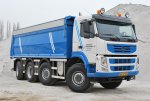

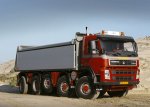
[video=youtube;7VnjKRS4ttc]https://www.youtube.com/watch?v=7VnjKRS4ttc [/video]
See
http://www.terberg.nl/uk/industry/tractors-and-trucks.php ,
http://www.terbergbenschop.nl/uk/products/trucks_open.php ,
http://www.terbergtechniek.nl/uk/modifications/pusher-and-tag-axles.php , and
http://www.terbergtechniek.nl/uk/modifications/wheelbase-modifications.php .
At a more theoretical level, a Dutch entrepreneur who worked in mining in Indonesia has been trying to develop a completely new line of mining trucks, trucks in which all the axles steer:
[video=youtube;rWtJqdzw5as]https://www.youtube.com/watch?v=rWtJqdzw5as [/video] [video=youtube;t2FFaBPvvCo]https://www.youtube.com/watch?v=t2FFaBPvvCo&list=PLB1FBF9A6DC4CC0CB [/video]
[video=youtube;Tn8cXP0-o2c]https://www.youtube.com/watch?v=Tn8cXP0-o2c&list=UUFt6Oo-eMpLkhnzKWOrgGTw [/video]
See
http://www.oemoffhighway.com/article/10769943/non-rigid-design-of-a-rigid-haul-truck ,
http://www.etftrucks.eu/downloads/etf_brochure.pdf/ ,
http://www.etftrucks.eu ,
http://www.etftrucks.eu/Mining-Trucks/ ,
http://www.etftrucks.eu/Innovations/#.VCB-t3m9_6k ,
http://www.etftrucks.eu/Innovations/Axle-Configuration/ ,
http://www.etftrucks.eu/Innovations/Steering-System/ ,
http://www.etftrucks.eu/Pictures/ ,
https://www.youtube.com/user/ETFMiningTrucks , and
https://www.youtube.com/playlist?list=PL15A689C2F23F591F .
So far ETF's proposals all seem very theoretical, and I have not been able to find even one picture of a completed, real, living ETF truck. But the "
innovations" page on the ETF website makes for some very interesting reading!
And rear-wheel steering from more well-known manufacturers for demanding applications certainly is a technology that is
"available right now."
*************************************************
CONTINUED IN NEXT POST
.



